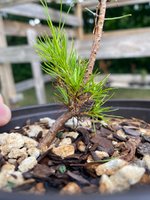I have not tried growing one yet. I was concerned they would not be fully winter hardy here. They might be now, might not be. My winters are definitely milder than they used to be. I did look Pinus echinata up on Wikipedia, and gleaned a few useful factoids that make it an interesting species to try for bonsai. It is in the Australes subsection of the genus Pinus. Making its close relatives Pinus taeda (Loblolly pine) and Pinus rigida (pitch pine). Both of these have a good track record as bonsai, with its ability to produce buds on old wood being particularly helpful. I would expect the same from Pinus echinata.
Hardiness - Wikipedia lists its native range as south of the Ohio River, most of SE USA. This would be USDA zone 7 and warmer climates. Most trees hardy in zone 7 can tolerate zone 6b, but might be iffy further north. So I doubt I could grow it as fully winter hardy here in zone 5b or 6a. With my cooler, shorter summers I would not expect to be able to get 2 flushes of growth per summer. In colder climates expect to treat it as a single flush pine.
But like I said, I have not grown one, so this is conjecture on ,my part. It does look a good candidate for bonsai, along with P. taeda and P. rigida.
Note, if you are raising a batch of seedlings. One of the negative traits for bonsai of this group of pines is needles tend to have a twist to them . Twisted needles is a variable trait, in a batch of seedlings some will have more strongly twisting needles and some will have less twisting in the needles. When selecting which seedlings to keep and which to "move on" keep the ones with less twisting all other traits being equal.














